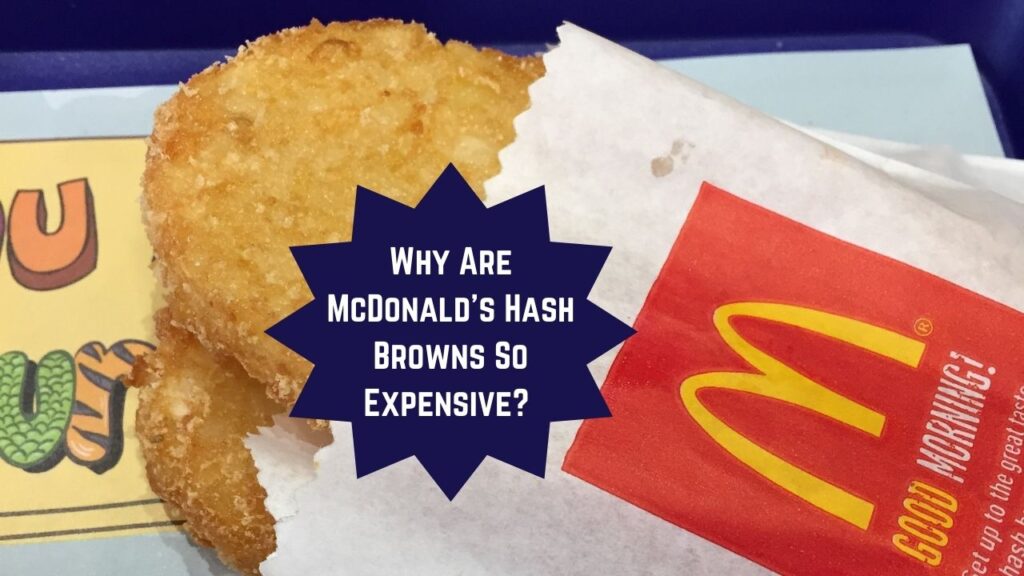Why Are McDonald’s Hash Browns So Expensive? McDonald’s hash browns have become more expensive due to inflation and rising operational costs, including increased prices for raw materials and labor.
If you’ve recently visited McDonald’s for your morning breakfast, you might have noticed that the cost of their crispy, golden hash browns has gone up.
While these delicious breakfast treats have been a staple for many, the unexpected price hike has left some customers scratching their heads.
Why are McDonald’s hash browns so expensive all of a sudden? In this article, we’ll break down the factors that have led to this price increase and how it’s affecting both McDonald’s and its customers.
What Makes McDonald’s Hash Browns So Special?
Before diving into the price hike, let’s first take a moment to appreciate what makes McDonald’s hash browns so iconic. [Why Are McDonald’s Hash Browns So Expensive?]
Made from finely grated potatoes, these hash browns are deep-fried to crispy perfection, making them the perfect complement to an Egg McMuffin or a cup of hot coffee.
For many, they’re a beloved part of their daily routine, whether you’re picking up breakfast on your way to work or enjoying a leisurely weekend meal.
There’s something about the combination of crispy edges and soft, flavorful potato interior that keeps customers coming back.
Unlike homemade hash browns, which can often fall flat or end up soggy, McDonald’s has perfected the art of creating the perfect golden-brown crisp that maintains its texture and flavor until the very last bite.
This consistency has made McDonald’s hash browns a go-to item for breakfast enthusiasts across the world.
However, McDonald’s has faced some challenges over the years. [Why Are McDonald’s Hash Browns So Expensive?]
From maintaining consistency in taste and texture across all their locations to meeting the ever-changing demands of customers, hash browns are no longer the budget-friendly item they once were.
Let’s take a look at the reasons behind the price increases. [Why Are McDonald’s Hash Browns So Expensive?]
Reasons Behind the Price Increase
Inflation and Rising Operational Costs
The most significant factor contributing to the higher prices of McDonald’s hash browns is inflation. Inflation is the general increase in the price level of goods and services over time, and it’s been affecting businesses of all sizes.
As the cost of goods, services, and wages increases nationwide, fast food chains like McDonald’s must adjust their menu prices to keep up. [Why Are McDonald’s Hash Browns So Expensive?]
This includes higher expenses for not only the ingredients that make up your hash browns but also the operational costs that go into running the business, such as utilities, rent, and packaging.
The cost of raw materials, such as the potatoes used for the hash browns, has also risen substantially. McDonald’s, like other chains, must pass on some of these higher costs to consumers in the form of price hikes.
Potatoes themselves are an agricultural product, and their cost can fluctuate depending on supply and demand, weather conditions, and transportation costs.
As inflation drives up the cost of these inputs, it becomes increasingly difficult for McDonald’s to maintain their previous price point without absorbing these costs.
At the same time, McDonald’s must also contend with the rising cost of fuel, which affects transportation expenses. [Why Are McDonald’s Hash Browns So Expensive?]
As fuel prices climb, the cost of delivering ingredients to McDonald’s locations increases as well, further driving up costs.
Fuel surcharges are now a common occurrence in supply chains, and this has made it even more difficult for restaurants to maintain their margins.
Supply Chain Challenges
In recent years, the global supply chain has faced significant disruptions, and it’s had a major impact on the food industry. [Why Are McDonald’s Hash Browns So Expensive?]
The COVID-19 pandemic, extreme weather events, and global shipping delays have all played a role in the increased difficulty of sourcing key ingredients.
Potato crop shortages in certain regions, caused by a combination of climate issues and logistical delays, have made potatoes harder and more expensive to procure.
As a result, suppliers of frozen potato products, which McDonald’s relies on for their hash browns, have raised their prices.
These supply chain issues have affected not only the cost of potatoes but also the cost of transportation and packaging. [Why Are McDonald’s Hash Browns So Expensive?]
With delivery delays and higher fuel prices, it’s becoming more expensive for McDonald’s to keep its hash browns in stock at the same price point.
Transportation issues also mean longer delivery times, which increases costs for everything from storage to shelf life management.
In addition to logistical challenges, McDonald’s must also navigate regulatory changes, including tariffs and trade agreements that can affect the price of imported ingredients.
If new trade policies or tariffs increase the cost of goods from other countries, it’s likely that McDonald’s will pass on some of those costs to consumers, including those who rely on staple items like hash browns.
Increased Labor Costs
Another reason McDonald’s hash browns have become more expensive is the increase in labor costs.
In several regions, minimum wage laws have been raised, and fast-food chains like McDonald’s are now paying their workers more.
While this is a positive development for employees, it adds to the overall cost of running a fast-food chain.
Higher wages mean higher prices for everything from the cost of preparing your meal to the efficiency of the service you receive at the counter.
In particular, areas with significant labor law changes, such as California, have seen McDonald’s and other fast-food chains raise prices to offset increased labor expenses.
For example, California has seen its minimum wage increase in recent years, and workers in fast food restaurants are now earning more than ever before. [Why Are McDonald’s Hash Browns So Expensive?]
While this is a win for workers, it also means that companies like McDonald’s must adjust their pricing structure to maintain profitability.
Additionally, McDonald’s has made investments in its workforce by offering better benefits, training programs, and more opportunities for advancement.
These initiatives come with costs, which ultimately affect the prices consumers pay for menu items like hash browns.
The Effect on McDonald’s Menu Prices
If you’ve noticed an increase in the price of hash browns, you’re not alone. In fact, this is a part of a larger trend in McDonald’s pricing across the board.
Many customers have commented on the rising cost of breakfast items, and McDonald’s is not the only chain to face such price hikes.
Chains like Wendy’s, Burger King, and Starbucks have all experienced similar shifts in their menu prices. [Why Are McDonald’s Hash Browns So Expensive?]
When you compare McDonald’s hash browns to other items on their menu, you might notice that the increase is part of a larger price adjustment across various items.
For instance, other popular breakfast options like the Sausage McMuffin or the Bacon, Egg & Cheese Biscuit have also experienced slight increases in recent years.
While the price of hash browns may seem relatively small in comparison, it’s part of a broader effort by McDonald’s to keep up with rising costs.
However, McDonald’s has worked to keep its pricing competitive within the fast-food industry. Even with the price increase, the company still strives to offer menu items at a value that attracts customers.
Despite the higher prices, McDonald’s remains one of the top choices for breakfast on the go, and its hash browns continue to be a popular option for those looking for a quick, satisfying meal.
Impact on Customers and Business
For customers, the price hike has been met with mixed reactions. Some are understanding of the external factors causing the price increase, recognizing that inflation, supply chain issues, and higher wages are affecting everyone.
Others, however, feel that the increase in price may be a bit too much, especially for an item that was once seen as an affordable breakfast option.
It’s not just customers who are impacted by these changes. McDonald’s, as a business, must carefully weigh the effects of price hikes on customer satisfaction and brand loyalty.
While price increases can sometimes lead to dissatisfaction, McDonald’s is hoping that customers will continue to choose their restaurants for the quality, consistency, and convenience that they are known for.
On the business side, McDonald’s must balance the need to increase prices to cover rising costs with the desire to keep its customers happy. [Why Are McDonald’s Hash Browns So Expensive?]
After all, McDonald’s is still committed to offering value and convenience to customers, and pricing plays a big role in their decision-making process.
However, if McDonald’s raises prices too high, it risks losing its competitive edge, especially with so many other fast food chains offering similar menu options.
See Also: Why Is Chick Fil A So Expensive? The Truth!
Final Verdict: Why Are McDonald’s Hash Browns So Expensive?
So, why are McDonald’s hash browns so expensive now? The price increases can be traced to a combination of inflation, supply chain disruptions, and rising labor costs.
These factors have affected not only McDonald’s hash browns but many other items on their menu as well. While the higher prices might be disappointing for some, they are a reflection of the broader economic forces at play.
If you’re still craving those crispy hash browns, it’s important to recognize that the price you’re paying reflects the challenges McDonald’s is facing to provide you with a consistent, high-quality product.
Despite the price hikes, McDonald’s remains a go-to destination for millions of customers worldwide, and their hash browns continue to be one of the most popular breakfast items.
FAQs
Q1: How often do McDonald’s hash brown prices change?
Price changes at McDonald’s typically occur when there are significant shifts in raw material costs or operational expenses. While the price of hash browns can vary by location, these changes are usually implemented across the board.
Q2: Are other fast food chains experiencing similar price increases?
Yes, many fast food chains are facing similar challenges due to inflation and supply chain issues, which has led to price increases across various menus. [Why Are McDonald’s Hash Browns So Expensive?]
Q3: Can McDonald’s reduce costs without sacrificing quality?
While McDonald’s is always looking for ways to streamline its operations and reduce costs, it’s challenging to maintain quality standards while cutting back on expenses. The price increase helps ensure the continued availability of high-quality ingredients.
Q4: How does McDonald’s handle supply chain issues?
McDonald’s works closely with suppliers to ensure consistency and manage supply chain disruptions. However, when there are widespread issues, like potato crop shortages, these factors can affect product prices.

Hello, I’m Ashlyn Fleming from Sedona, Arizona. After finishing my Master’s, I noticed rising prices on everything I buy for my family. Curious about why, I started a blog to share my findings with friends and family.
